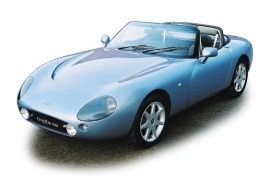
TVR Griffith
Generations Timeline, Specs and Pictures

After ending the production of the 1991 model Griffith in 2002, the British car-maker TVR went into silence for over a decade about their flagship model and, in 2017, it unveiled the next generation.
It was unveiled at the Goodwood Festival of Speed. It took the center stage and made the wealthy guests open their check-books. But the car was to be released as a series model in 2020. Due to the pandemic situation and the fact that there was no factory, the car was still gathering orders and nobody could tell when they will be delivered.
Back to the car itself. The 2020 Griffith featured a new, bold design with LED headlights and a sculptured front area. The wide grill was placed lower, with two side air-intakes to enhance the aerodynamic. An arched roofline with a short 2-seat cabin with a large shelf for luggage in the back. On the sides, behind the front fenders, the concept-car featured the exhausts on each side. Most probably those will be moved to the back, under the big diffuser, since the safety regulations forbid the side exhausts.
Inside, the Griffith featured a TFT display for the instrument cluster and a touch-screen display for the infotainment system. Since TVR designed its vehicles in a different way than other sports-cars manufacturers, it showed an interior with a different layout for buttons and controls. The driver was surrounded by the center console. The entire car was focused on the driver. It was a true driver’s car.
The engine was a 5.0-liter Cosworth V8 mated to a 6-speed manual. The 50:50 weight distribution contributed to the car’s handling along with the independent suspension in all corners. The extensive use of carbon-fiber elements led to a low weight of only 1250 kg (2756 lbs).

TVR introduced the Griffith in 1992 as a replacement for the S-Series but made it on top of the Tuscan’s racer chassis, which led to a sportier vehicle.
The British car manufacturer produced the Griffith with a Rover V-8 engine in the first year of production with either 4.0- or a 4.3-liter displacement. Then the factory closed for a few months in 1993 for upgrading the assembly lines, and when TVR reopened it, the Griffith received only the 5.0-liter unit. Thanks to its low weight, the Griffith was a fierce sports car in proper hands or a widow-maker in the hands of an inexperienced driver. It was the real British roadster but powered by a V-8.
TVR took care of the car’s aerodynamic and covered the round headlights with clear-glass profiled to cut into the air. The oval-shaped grille at the front was narrow, and the hood sported a wide vent that extracted the hot air behind the radiator. On the sides, the car sported an arched sculptured line between the front fenders and the doors. To enter the car, the carmaker added grab handles on the top-rear side of the doors. After the short, sloped trunk area, the back panel was flat and vertical. It sported big, vertical taillights.
Inside, the Griffith offered room for two passengers and an aluminum instrument panel with individual dials and gauges, plus a few warning lights. Later on, the carmaker provided an option for a wood panel. Also, starting with 1995, TVR offered power steering, which became a standard feature beginning in 1999.
TVR launched the last series of the Griffith in 2001, known as the Griffith 500 in 100 units, which was faster than the Ferrari 512TR or the V-10 powered Dodge Viper.























































